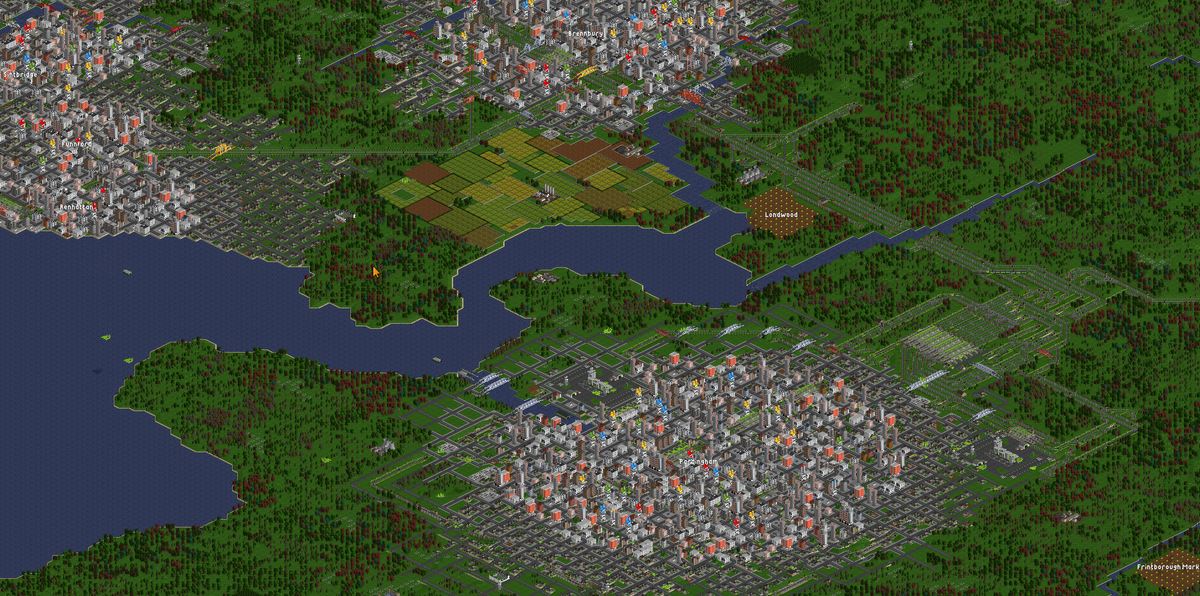
OpenTTD is a game where you build a transportation empire with road vehicles, trains, boats, and planes. It’s an open-source remake of a game called Transport Tycoon by Chris Sawyer, released in 1994. I have been playing it for many years; I have no idea how many hours I’ve sunk into it.
There are a few setting changes that I consider essential. It’s bizarre to me that these aren’t the defaults - I guess OpenTTD is trying to keep close to the original 1994 game. I like to focus on passenger and mail services, and therefore consider these essential.
Road layout #
OpenTTD’s default road layout, “original”, wastes space by building lots of unnecessary roads and slows down town growth. You should set “default road layout for new towns” to “Better roads” instead - it has an almost identical result but requires at least two tiles between parallel roads.
You could also consider using a grid or manual road placement, by turning off “towns can build roads”.
Town growth in OpenTTD sucks. No matter the road layout you choose, the growth algorithm has a flaw that limits the growth of a city. It uses a “random walk” that gives up after a certain distance. Having lots of junctions can cause the algorithm to get lost, which slows down town growth. The original town layout has the most junctions of all town layouts. The solution for town growth is to use tunnels as shortcuts to the outskirts of the city, or to turn off “towns build roads” and instead build towns in a spiral.
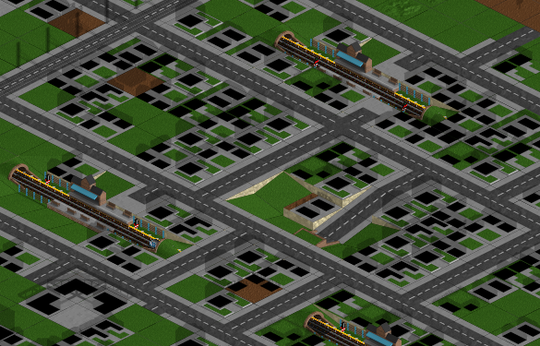
Towns are allowed to build level crossings #
There’s nothing more terrifying than hearing the “ding ding ding” of a level crossing in OpenTTD. By default, towns like to build level crossings over busy railways. You can turn this off in the settings.
Cargo distribution #
By default, passengers and mail in OpenTTD are dumb. They get on the train and get off at the next stop, unless you manually transfer them.
Cargo distribution is a feature that simulates destinations for passengers. They will get on the bus to a train station, catch the train to a nearby city, and then get on the bus again to where they want to go. This is all done completely automatically, no need to manually do transfer orders!
This is such an important feature, I can’t believe they’ve hidden it into obscurity by disabling it by default.
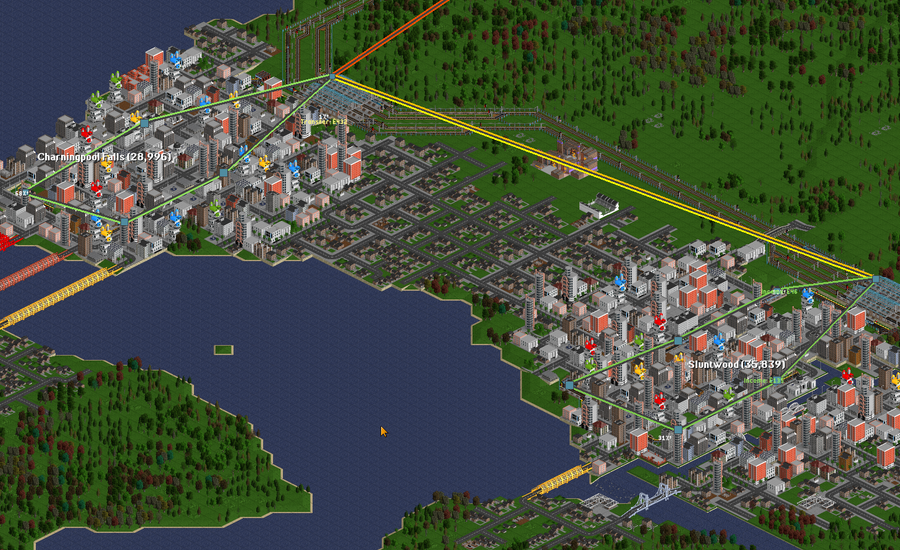
Cargo distribution makes passenger and mail focused games much more interesting. You can now use a hierarchy of transport - with local buses/trams, regional trains, high speed trains.
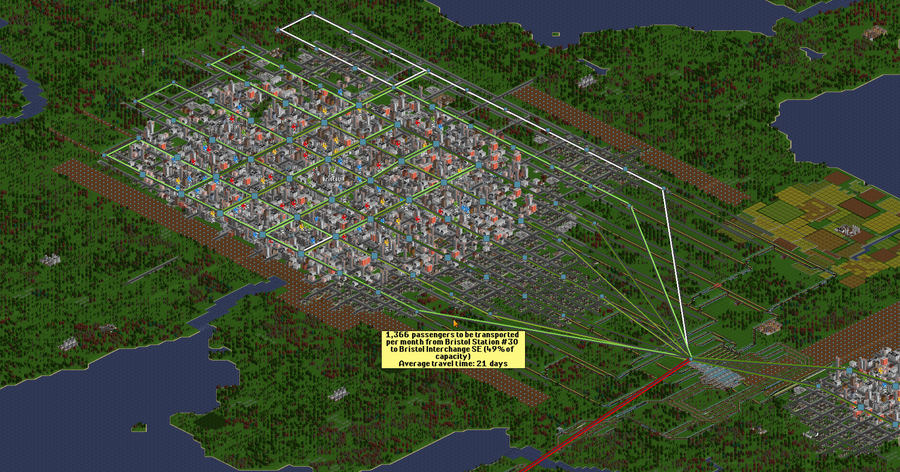
You should set the “distribution mode for passengers” to “symmetric” and for mail to “asymmetric”. This will simulate return journeys for passengers.
Number of plane crashes #
Every plane landing has at least a 0.07% chance to crash and burn in OpenTTD, without a way to prevent it. This is insane, plane crashes are very rare in real life. You should set “Number of plane crashes” to “none”. Large planes may still crash when landing on a small airport.
That being said, planes are quite overpowered in OpenTTD so maybe this is by design.
Automatically pause when starting a new game #
Starting a new game paused gives time to assess the map for resources without losing money to loan interests and other costs.
Default rail type #
Sick of accidentally placing normal rail on an electric AC rail line? Change “default rail type” to “most used” so that it defaults to the correct type when loading a game.
Show the cargoes the vehicles can carry in the list windows #
Enabling this option shows what types of cargo a vehicle can carry. It makes reading the vehicle lists much easier.
Multiplayer settings #
- Allow level crossings with roads or rails owned by competitors: off
- Allow buying exclusive transport rights: off
- Allow funding local road reconstruction: off
Bonus: train length and station size #
I like to increase the maximum train length and station size to get more realistic train lengths. I don’t necessarily think these should be changed by default for all users.
- Maximum length of trains 10 (Default: 7)
- Maximum station spread 14 (Default: 12)
Bonus: trams #
Not a setting, but a NewGRF - OpenTTD really should come with “Improved Generic Tram Set” by default.
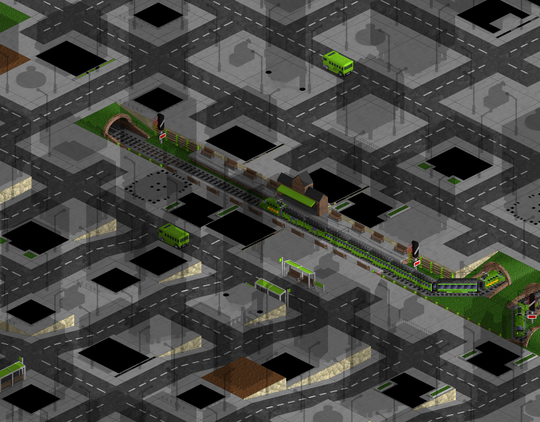
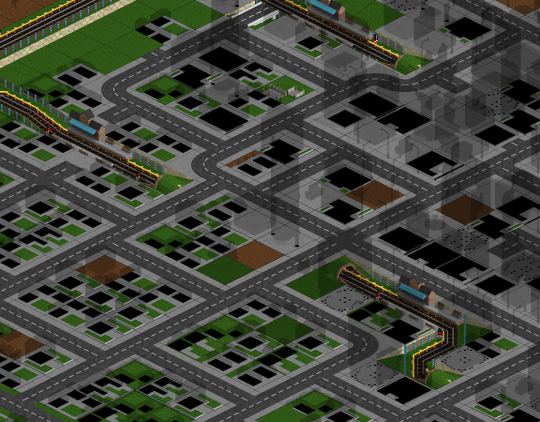
Comments